Some Most Basic Celestial Mechanics
The Objects in the Night Sky
Well. Now that you know what amateur astronomy is, and the Universe, you might want to get some further data in terms of what we could call the celestial mechanics related to basic amateur astronomy, or what objects are populating the night sky
![]()
Some Most Basic Celestial Mechanics
The Objects in the Night Sky
More basic concepts about how all that works, as far as it is related to the observation like an amateur!
| The Celestial Sphere The Earth is Revolving on Itself The Concept of Seasons in Terms of the Night Sky |
The Seasons |
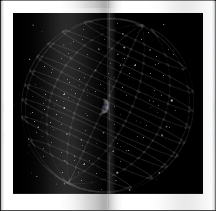 | any star, at night, seem affixed unto a sphere which seem to surround the Earth, which is called the celestial sphere. picture site 'Amateur Astronomy' |
You know that the Earth, is just hanging -and moving- in the solar system, around the Sun! This means that we're hovering in the void of space, as far as our relationship to the night sky is concerned
Due to that position, all the stars of the night sky seem to be affixed on a sphere surrounding us, and at a same distance. Just look the sky at night and you can't tell that any star seems nearer to us than any other. All appear like dots of light, on the ultramarine blue background of the night!
This sphere which seems to surround us is just called the celestial sphere. And where do all those stars belong, could you ask? Well, they do are part of the Milky Way Galaxy, simply! With our Sun, the Earth -and us- are just part of a gigantic set of stars, which is called a 'galaxy'. A galaxy is a group of hundreds of billion stars and such popular pictures like the Pinwheel, or the Andromeda galaxies, have well popularized such those objects of the Universe. Like said, the Earth, with the Sun and the solar system, is just one of those billion stars in one of those galaxies, which we call our own, the Milky Way Galaxy that is. Should the Sun be the size of the dot of an 'i' on this page, the Milky Way would stretch from Los Angeles to New-York! All those stars we see in the night, are just a part of all those billion stars. This mostly mean, on another hand, that we see just the stars relatively nearest to us, as the rest is just seen under those veils of faint and indistinct luminosity which we call the Milky Way. As we are inside the Galaxy, we can't see it under its form of a pinwheel, but, on the one hand, we see it, when looking edge-on, either side of us, under the form of the Milky Way (it's the Milky Way Galaxy seen edge-on), and of the rest of the starry sky (it's the Milky Way Galaxy seen through)!
As far as the concept of Earth's hemispheres is concerned, the description of the celestial sphere remains the same. The only difference, as you will see, stands in that the dwellers of the southern hemisphere are allowed for the southernmost parts of it, compared to the northerners, as the inhabitants of the tropical regions are treated with views of both the parts of the celestial sphere
You know, on another hand, that the Earth is revolving about itself each 24 hours. This determines the day, and the night. This, too, determines the apparent motion of the celestial bodies in our skies: during the day, you'll be able to see the Sun rising East, climbing into the sky until about midday, and then descent back to the West, to the horizon, and set. The same is true, albeit less obvious for the night sky. Should you stay a sufficient time under the night sky, you would see how any part of the sky is rising East, reaching its highest southwards, and then get down to the horizon, West, and set there. That motion occurs at a rate of 15° each one hour!
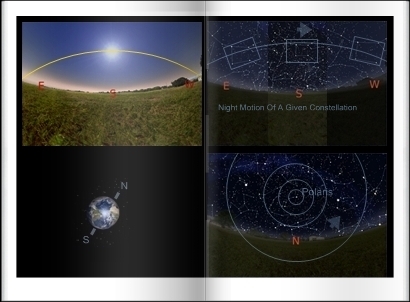 | due to the rotation of the Earth about istself, any celestial body, the stars included seems to rise East and to set West, as, due to the Earth's axis tilt, all the celestial sphere seems to rotate about the Polaris. picture site 'Amateur Astronomy' |
More specifically, as the Earth's axis, the imaginary line joining the south and north poles is tilted (by some 23.5°), all the celestial sphere seems to be axed unto the famed Polaris, that star which points to the North, in the northern hemisphere, and revolve about it!
As far as your position at Earth is concerned, in terms of latitude, the concept remains the same. The only difference is related to that, at the tropics, the Sun mostly rises due East and sets due West, arching over the zenith, as, in the southern hemisphere, you will be able to see how the Sun, there, is journeying, from the East to the West, into the northern part of their sky (at noon, that is, the Sun is seen North). At night, at the tropics, the motion of the Earth is having the sky moving straight up from the East to the zenith and then West, as, in the southern hemisphere, the sky, when facing South, is seen, just like in the North, revolving aroung the southern celestial pole (they don't have there however the equivalent of the Polaris to mark that pole, and the stars are seen rising at your left (East), getting elevated, and then setting at your right (West)
Another concept, at last, is to be take in consideration as far as the night sky is concerned. The Earth is performing an orbit around the Sun, which lasts one year. At each of the four defining moments of this orbit (which, technically, are the official, astronomical beginnings of the four seasons, the winter and summer solstices, and the spring and fall equinoxes, namely), we on the Earth, at night, we are looking at a different part of the celestial sphere, like illustrated on the diagram here! This leads to that, in terms of observation of the night sky, it's customary to speak about 'seasonal skies'. This means that, at each season, a part of the sky only is mainly seen at that epoch, with its distinctive constellations and features! Thus, during summer, you'll mainly see such or such constellations and parts of interest of the sky. In fall, should you keep into your interest into the hobby, you would be able to see the fall constellations and sky. Then the winter ones. And, at last, the spring constellations and sky features before, eventually, returning again to summer. The diagram assumes that we would be looking South, at about 10:30 p.m. local time (as a theoretical view related to the diagram is that, in fact, it would be midnight at our observation position, looking away from the Sun)
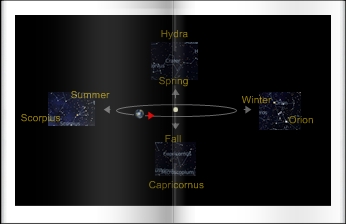 | the Earth, on its orbit around the Sun, makes that, at each season, we may reach a part of the sky only, defining 'seasonal skies'. picture site 'Amateur Astronomy' |
As far as you position related to the Earth's hemisphere is concerned, those seasonal skies remain a fact, with each season at the tropics or South, having some pecular regions of the sky proeminent. Another consideration, further, is that the constellations of the northern celestial sphere are shifting the more you go South, through the Equator, eventually being seen upside down in the southern hemisphere. The seasons, of course, are reverted South, with the southern winter being the northern summer, etc.
The four seasons, at Earth -winter, spring, summer, and fall- are some defining moments, impacting the length of days, nights... and the weather! The four seasons are just, indeed, four astronomical moments. That's much easy to understand. Let's first consider that the Earth's axis (this imaginary line joining both the South and North poles) is tilted. That's the result of a most antique time, just linked to the formation of the Earth and the interaction with the Moon. The tilt, accurately, is of 23.5°. That tilt just is unaffected by the revolution of the Earth on its orbit! And that is of consequence. At some point of the orbit of the Earth, the Earth's axis is tilted towards the Sun, as at another point, it's tilted away, and at some moments, it's neutral -neither tilted towards nor away!
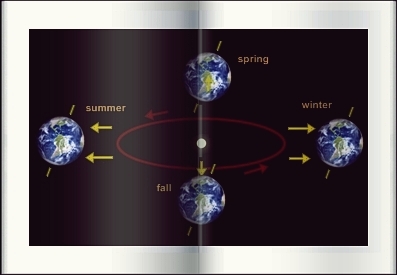
Four pecular moments on the orbit define precisely the seasons (just like illustrated above)
As far as Earth's hemispheres are concerned, seasons are reverted of course. When it's winter North, is summer South e.g. This is due to that when the northern hemisphere is at a given tilt relative to the Sun, the southern hemisphere is correlatively at the opposite tilt. Strictly speaking equatorial regions do not have any delineated seasons. Temperatures, vegetation, and the length of days are remaining identical all year long! Some last, advanced considerations: as the Earth's orbit is not exactly a circle but an ellipse, Earth, at a moment of the year, is nearest to the Sun and at its farthest, at another moment. The nearest point is termed the 'perihelion', the farthest is the "aphelion" (from the Greek 'peri' ('near'), 'a' (privative, 'far'), and 'helios' (the Sun)). The perihelion takes place each year about January, 2nd, as the aphelion about July, 4th. As such an inconsistency is of few importance in the northern hemisphere, it is much more important in the southern hemisphere. It's when the southern part of the Earth is tilted towards the Sun that Earth, at the same time, is nearest to the Sun hence southern summers are warmer than the northern ones! On the other hand, the aphelion does not yield colder southern winters however. This might be due to the oceans, with their much more important surface in the southern hemisphere, thus having a tempering effect!
What can you expect to see in the night sky?
| The Stars and the Constellations Planets |
The Moon ... And More! |
Stars are nothing else than just suns like our Sun! At the sole exception that, on the one hand, they are situated at much far distances than the Sun, and that, on the other hand, they are not necessarily of the same size than it, some being much larger, or some smaller. As an exemple, our Sun is located some 93,000,000 miles (150,000,000 kilometers) from us as nearest stars from us are located at about 5 light-years, five times 5.9 trillion miles (9,5 trillion km) that is! The sole fact that the astronomers are using another scale to render such distances is enough to show those enormous distances separating us from the stars! As far as their size is concerned, some stars may reach as far as 220 times our Sun' radius. Such a star, like Betelgeuse thus has a diameter of 186 million miles (300 million km). If placed at the place of our Sun, that star would reach far beyond the orbit of Mars
The starry night is not a vain expression! Any night, the sky is peppered with stars! In fact, all in all and for the whole of the sky, you would be able, naked-eye, to see 5026 stars
Due to that stars are far enough to be seen seemingly at the same distance from us, they are mostly differentiated, in our night sky, through their luminosity. The apparent closenesses, or grouping between them, of various numbers of stars was readily observed by all the civilizations of the world, which led to that most of them attributed names and/or significances to those groupings. Progressively, those groupings and closenesses eventually came to be rationalized, and perpetuated along. Such closenesses and groupings of stars, seen like figures, are called 'constellations'
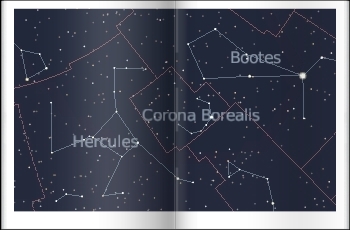 | constellations are defined, at the same time, like figures resulting from the closenesses of some stars, and like all the stars enclosed into some boundaries. Constellations seen here are, from left to right, Hercules, the Heroe, Corona Borealis, the Northern Crown, and Bootes, the Herdsman. picture with Stellarium |
The constellations today are still extent and the ones which are drawn on any sky chart are largely due to Babylonians and Greeks for the constellations themselves, as the star names, on the other hand, are mostly due to Arabs. Definitive constellations boundaries were fixed in 1930 by the International Astronomical Union (IAU) as the number of constellations was fixed at 88. A base to today constellations are the famous 48 constellations which were recensed by the Greek astronomer Ptolemy
Thus, the whole sky is organized into those constellations, both determining a series of bonds between stars which are close together, and each constellation having boundaries. Leo, the Lion, Andromeda, Andromeda, or Cygnus, the Swan are constellations. The astronomers further are referring to 'asterisms'. A asterism is a part only of a constellation which presents a striking and unmistakable figure. Such famed asterisms are, for example, the Leo's Sickle (part of constellation Leo) or the Great Square of Pegasus (part of Pegasus, the Winged Horse). You may note that the famed Great Dipper, which most probably is the most known of the constellations to any casual amateur of the night sky, is not, in fact, a constellation. It's an asterism inside the broader figure of Ursa Major, the Great Bear!
The Anglo-Saxon practice is that the constellations' names are their name in Latin, followed by the translation of it in English. Thus Cygnus, the Swan, Hercules, the Heroe, Leo, the Lion, or Draco, the Dragon, for example
As far as the stars are concerned, the most bright of them bear names. Those names, generally, are related to various cultures through which these names were given. Oldest are Greek, like 'Antares', some are due to the ancient Rome, like 'Regulus', as the greatest number of stars' names are derived from names Arab astronomers used in the Middle Ages, based on their peoples' use (like Altair, or Deneb, for example)
Some more technique, at last! Let's say some words about the 'magnitude' of stars! The magnitude of stars is a set of scale which allows to say what the luminosity of a star is. That scale of luminosity dates back to the Greeks, when stars had been divided into six classes. The brightest stars were in the first class and the faintest in the 6th. Each class of magnitude represents a star's brightness 2.512 times fainter than the previous. I.e. a star of the 3rd magnitude is 2.5 times less bright than a star of the 2nd magnitude, as it is 2.5 times brighter than a star of the 4th magnitude. The magnitude scale starts at 0. Stars which are brighter than the class 1 are termed negative (Sirius, for example, the brightest star in Northern hemisphere had a magnitude of -1.5). At night, naked-eye, you're able to reach down to the 6th magnitude stars and celestial objects only. To get to the stars below, you'll need an instrument
Planets are the other objects you may encounter in the night sky! Those are just the 8 other planets which compose the solar system with our Earth! Of them, on the other hand, 5 only may be seen naked-eye, Mercury, Venus, Mars, Jupiter and Saturn namely, as Uranus, Neptune, and Pluto are too dim to be spotted naked-eye. Two planets are seen like evening or morning stars only, Mercury and Venus that is, as most other naked-eye, or instrument planets are too be seen along the zodiac, at varied positions along the year, function of the relative motion of the Earth and them on their orbits. Any observation of the planets like a world per se needs an instrument and a minimum of about a magnification of x45. Planets, in term of amateur astronomy, are fine object to see in the dedicated instruments -the refractors or reflectors- the amateurs are using, each one with its beauties. Venus and Mercury are strikingly displaying phases similar to those of the Moon. Mars is the famed red planet (and somewhat a difficult object, needing high magnification powers) as Jupiter is an easy, round and striped object, with its 4 main satellites seen moving around it in matter of hours, and that Saturn displays its famed ring!
As far as the observation's location is concerned, you will note that, in the northern hemisphere, the globes of the planets are seen with their North to the top, and their South to their bottom. In the equatorial regions and the tropics, the planets are seen lying on their side, with their polar axis seen parallel to the horizon. Saturn's ring, thus, is just seen plane to the horizon! In the southern hemisphere, further, the planets are just see upside down, with their South at the top of their globe, and their North at the bottom!
The Moon is Earth's moon! It's located at just 239,000 miles (380,000 kilometeres) from us. Due to its regular orbit around the Earth and its relative position to the Earth and the Sun, the Moon, thus, is performing, on about a month's duration, its same sequence of phases. The Moon, on the other hand, due to its revolution period around the Earth equaling its rotation period on itself, always had the same side of it facing Earth. The far side of the Moon remained unknown until the space age!
 | click to Moon's phases |
In the northern hemisphere, just after the new moon, the first crescent Moon appears West and day after day, it gets distant from the Sun at the same time is increases in size. A famed, remarkable faint light which is displayed during that Moon is a crescent or a quarter. This is called the 'ashen light', the 'ashen glow', or the 'Earthshine", and it is a fine show. Moon's part which is still in night is lit by "earthshine". For an observer located on the Moon it would be night and Earth would be shortly after "Full Earth", ornating their skies. The ashen glow is seen too at last quarter Moon when last crescent is rising on eastern horizon. A popular expression is terming the ashen glow "the old Moon in the New Moon's arms". At first quarter Moon appears full South when Sun sets. The quarter Moon become waxing gibbous and it appears more East each day. When Moon reaches full, it's rising East just when Sun is setting West. Moon then sets in turn about 12 hours later that is by next morning. Waning gibbous Moon rises later each day until it reaches last quarter. Moon then rises at midnight and sets about midday. The last crescent completes the cycle as it rises less and less early before Sun. Generally, each night, the Moon is moving by about 12.5° relative to the background stars where it was located the previous day. In terms of the observer's location, what has been said about the planets' aspect at the tropics or the southern hemisphere is true for the Moon. At the tropics and the equator, the Moon's globe is seen lying on its side, as, in the southern hemisphere, the Moon is seen upside down, with the South seen up, and the North at the bottom! Another remarkable fact about the Moon is the southern hemisphere is thus, that the crescent aspect is reverted compared to the northern hemisphere, along with the monthly apparent journey of the Moon into the sky: the Moon phases are unfolding, in the sky, from the northwest to the northeast, as, for example, the horns of the first crescent Moon are turned to the North, instead of the South in the northern hemisphere
Any instrument, and even binoculars, will introduce you easily to the marvels of Moon. You'll see how the Moon's terrain is parting between bright, old, mountaneous regions, flat, dark, large plains, and as it's variously spotted with varied craters! Another observation will be too that the relief features are more accurately seen along what is called the 'terminator', that line which defines in what phase the Moon currently is (it's where the surface of the Moon divides into the part which is lit by the Sun, and the part which is not). Moon was reached by man during the 1960's and the beginning of the 1970's by the Apollo missions as the USA are aiming to bring man back to Moon about 2020 now
What else to be seen in the night sky? More still, with the Milky Way, shooting stars, or more!
Another striking aspect of the sky which is at reach during the summer nights is the Milky Way! The Milky Way is that vast band of faintly glowing draperies which is seen stretching into the night sky, mostly stretching from a horizon to the other. That's a great view! What the Milky Way is, in fact? The Milky Way -and that's interesting- is just our Milky Way Galaxy as seen edge-on and from the interior! We, with the Earth, the Sun, and the solar system, are part of one of those spinwheel galaxies which have been popularized by such pictures of the Andromeda galaxy or other remarkable such objects. As we are able to watch the spiral structure of those galaxies for the galaxies to which we don't belong, we can't see the one of our Galaxy due to that we are inside it. This provides us with the view of the Milky Way. From the inner of the Galaxy, when we're looking in the sky towards the plane of it, either side of our position in there, we are are seeing the most populated and densely packed regions of it. That's the Milky Way. And when we look towards the directions perpendicular to the plane, we see a more loosely populated sky (and technically, we can reach, through those less dense regions, to the outside of our Galaxy, to the other galaxies spread into the vastness of the Universe, and to the far reaches of the latter! During summer, in the northern hemisphere, the Milky Way is stretching from due South to the North. That's a remarkable show to imagine that we are seeing our spiral, pinwheel, Milky Way Galaxy edge-on, the plane of the arms that is. All those faintly glowing draperies are just those billions of stars located there and so numerous, and so much far from us that we can't individualize them anymore! We just see them under the form of that faint glow arching over the sky! Dark lanes of dust clouds are dimming or blocking too the Milky Way's faint glow. Most prominent dark lane stretches from the constellations Cygnus to Sagittarius and is often called the Great Rift, sometimes the Dark Rift
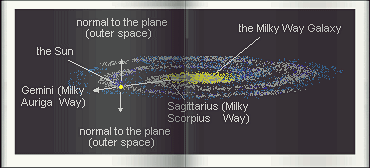 | our Milky Way Galaxy is of the pinwheel, spiral type, with arms spiraling from a central bulge. The arms and bulge, as seen edge-on and from the interior, yield the Milky Way arching in our night skies! picture site 'Amateur Astronomy' |
The plain view of the Milky Way, of course, is reserved to those who have dark skies enough for the view, due to that any important source of light will wash down its luminosity however. Another show of interest, as related to the Milky Way, during summer, is that, due South, in the constellation Sagittarius, the Archer, we have the view of the center of the Milky Way Galaxy! It's there that, on the one hand, the bulge of old, yellowish stars of the pinwheel is located, and, on the other hand, that the supermassive black hole of the Galaxy is lurking! Like any other galaxy in the Universe, like the astronomers know now, our Milky Way Galaxy is harbouring a large, monstruous black hole in its center. Black holes are the places of the most high density in the Universe, places of the highest gravitational pull. From such a place, nothing, not even the light, which is the object with the highest speed in the Universe, can escape. The origin of why galaxies have such objects in their center is still badly known. Galactic black holes are still active, as they are mostly usually 'dormant' and quiet however. But, they may -about once every 10,000 years- swallow a passing star. When it comes to assumptions, black holes are believed to be the place of interconnection with places where the laws of physics might be completely different, or where it might be possible to travel in time. One thing is certain however. Should you venture for a long space journey, never approach a black hole of any kind. You would never be back!
A famed show into the night are too the shooting stars. Along the year, amateur observers may observe from time to time a luminous strike in the sky. This is a shooting star. Most of shooting stars are sporadic and about 6 per hour may be seen each night. Shooting stars are pieces of material, averaging in size from sand grain to pebbles, entering in the Earth's atmosphere, and burning due to friction. At some periods of the year however, shooting stars become more numerous. Up to 60 e.g. may be seen per hour then. These so-called meteor showers are due to meteorids streams orbiting the Sun. These swarms are leftovers from comets. Shooting stars perspectively appear to come from a same point of space
| Name | Dates | Usual date(s) of maximum | Hourly rate (ZHR; gives an idea of the intensity of the shower) | Radiant (the apparent point in the sky where the meteors seem to originate) |
|---|---|---|---|---|
| Quadrantids | Jan. 1-5 | Jan. 2-3 | 120 | 230 +49 |
| Lyrids | Apr. 16-25 | Apr. 21-22 | 15-18 | 271 +34 |
| Eta Aquarids | Apr. 19-May 28 | May 5-6 | 60 | 338 -01 |
| Southern Delta Aquarids | Jul. 12-Aug. 19 | Jul. 27-28 | 20 | 339 -16 |
| Perseids | Jul. 17-Aug. 24 | Aug. 11-12 | 100-110 | 046 +58 |
| Alpha Aurigids | Aug. 25-Sept. 5-8 | Sept. 1 | 7-10 | 084 +42 |
| Orionids | Oct. 2-Nov. 7 | Oct. 21-22 | 20-23 | 095 +16 |
| Leonids | Nov. 14-Nov. 21 | Nov. 17-19 | ability to storm | 153 +22 |
| Puppid-Velids | Dec. 1-Dec. 15 | about Dec. 7 | 10 | 123 -45 |
| Geminids | Dec. 7-Dec. 17 | Dec. 13-14 | 120 | 112 +33 |
| Ursids | Dec. 17-Dec. 26 | Dec. 22-23 | 10 | 217 +76 |
More objects, or phenomenons may be seen in the sky, as they may be rare, or they need an instrument or some too specific techniques. Such objects are of the sort of the northern lights (which are not observable in summer due to the midnight sun), a Sun or Moon eclipse, and faint objects like the star clusters, nebulae or galaxies. The Sun in itself is observable only through dedicated, safe techniques, as its observation without those techniques is extremely dangerous to the eyes, up to a definitive blindness (see more below)
| CAUTION! OBSERVING THE SUN IS DANGEROUS! OBSERVING THE SUN WITHOUT APPROPRIATE TECHNIQUES MAY HARM YOURSELF, CAUSING BLINDNESS AND/OR IRREVERSIBLE INJURIES! see what DEDICATED SAFE TECHNIQUES allow for a safe observation of the Sun! |
| CAUTION! OBSERVING A SOLAR ECLIPSE -WHATEVER THE FORM OF IT (total, annular, partial, etc.)- IS A MUCH DANGEROUS AS THE USUAL OBSERVATION OF THE SUN! OBSERVING A SOLAR ECLIPSE WITHOUT APPROPRIATE TECHNIQUES MAY HARM YOURSELF, CAUSING BLINDNESS AND/OR IRREVERSIBLE INJURIES! see what DEDICATED SAFE TECHNIQUES allow for a safe observation of a solar eclipse, whatever the form of it! |
->Feeling interested by the hobby? See more subjects, and detailed studies, at the site 'Amateur Astronomy'!
Website Manager: G. Guichard, site 'Amateur Astronomy,' http://stars5.6te.net. Page Editor: G. Guichard. last edited: 12/28/2010. contact us at ggwebsites@outlook.com